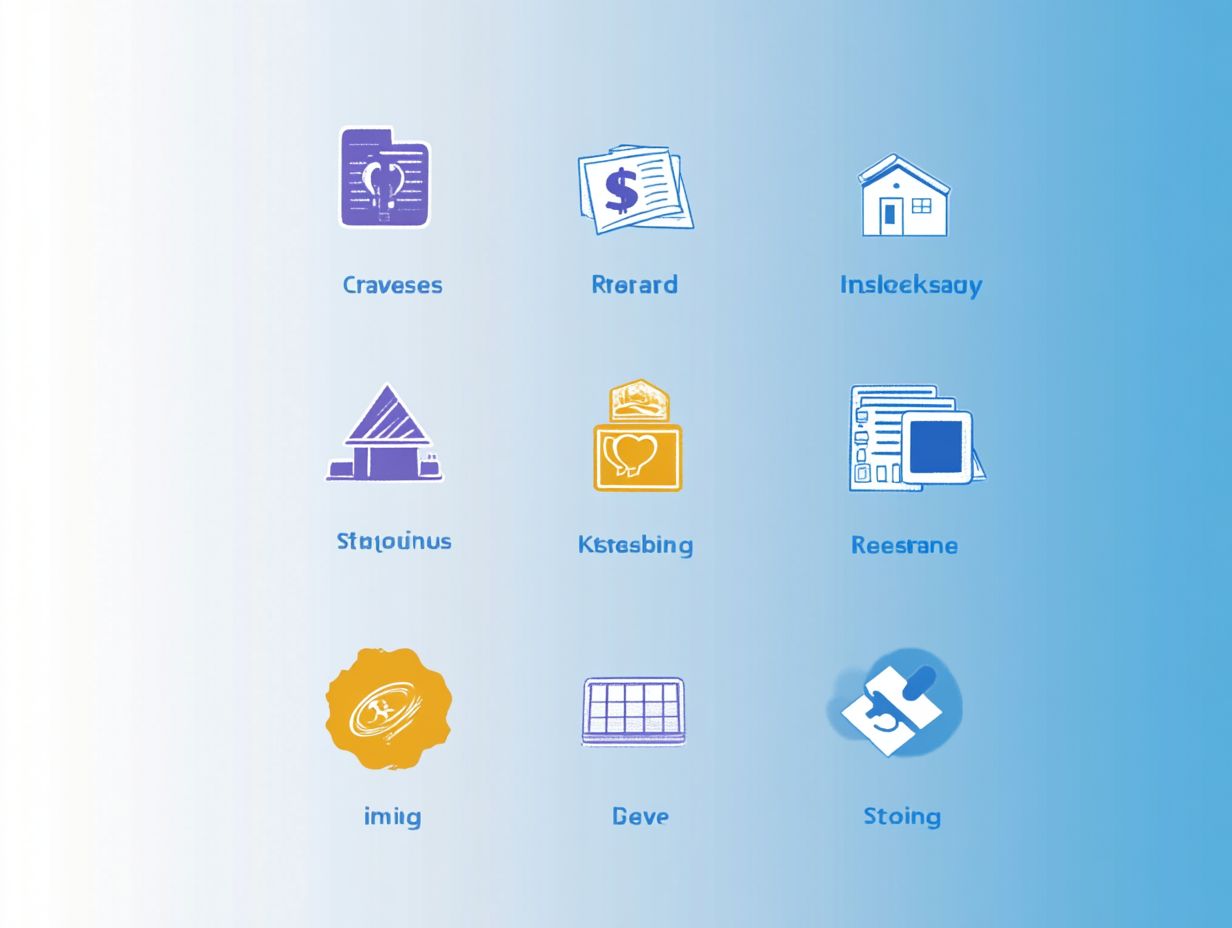Top 10 Retirement Savings Strategies
Planning for retirement can indeed feel overwhelming. However, effective savings strategies can make a significant difference in your financial future.
This article delves into ten essential tips designed to help you build a robust retirement nest egg, no matter your income level. You ll discover the importance of starting early, maximizing your employer-sponsored plans, and the benefits of IRAs, alongside the value of diversifying your investments.
Whether you re self-employed, earning a modest income, or enjoying a high salary, there s valuable insight here for you. We ll also tackle the reality of unexpected expenses and explore the potential of real estate as a retirement investment.
Ready to take charge of your future? Let s jump right in and uncover the secrets to a prosperous retirement!
Contents
- Key Takeaways:
- 1. Start Saving Early
- 2. Take Advantage of Employer-Sponsored Retirement Plans
- 3. Contribute to an Individual Retirement Account (IRA)
- 4. Consider a Roth IRA
- 5. Utilize Catch-Up Contributions
- 6. Diversify Your Retirement Savings
- 7. Don’t Touch Your Retirement Savings Early
- 8. Plan for Healthcare Expenses
- 9. Keep Track of Your Retirement Savings Progress
- 10. Consider Downsizing in Retirement
- What Are the Best Retirement Savings Strategies for Different Income Levels?
- How Can One Save for Retirement If They Have a Low Income?
- What Are the Retirement Savings Strategies for High-Income Earners?
- How Can One Save for Retirement If They Are Self-Employed?
- What Are the Pros and Cons of Investing in Real Estate for Retirement?
- How Can One Prepare for Unexpected Expenses in Retirement?
- Frequently Asked Questions
- What are the top 10 retirement savings strategies?
- How can starting to save early benefit my retirement?
- What is the importance of contributing to my employer’s retirement plan?
- How can I maximize my contributions to my retirement accounts?
- What is the difference between a Traditional and a Roth IRA?
- What are some other retirement savings strategies to consider?
Key Takeaways:

- Start saving early to take advantage of interest building over time.
- Make the most of employer-sponsored retirement plans like 401(k)s a retirement savings plan offered by your employer that helps you save money before taxes.
- Consider diversifying your retirement savings through individual retirement accounts (IRAs) and catch-up contributions.
1. Start Saving Early
Starting to save early for retirement is essential for building a solid financial foundation. It enables the process where your money earns more money over time to work in your favor, significantly boosting your retirement income.
Consulting a financial advisor and exploring various retirement strategies can help you create a customized retirement plan that aligns perfectly with your risk tolerance and investment goals.
Understanding the contribution limits for accounts like 401(k)s and IRAs can enhance your savings strategy, maximizing your potential for growth and security during your retirement years.
The earlier you start contributing, the more opportunities you have for growth. Even small, regular deposits can lead to significant earnings in the long run, often surprising those who wait too long to save.
When selecting a financial advisor, look for someone well-versed in retirement planning with experience in options that fit various risk profiles. Focus on spreading your money across different types of investments to ensure your portfolio withstands market volatility while meeting your long-term goals.
Regularly reassess your risk tolerance, especially as you age or experience life changes. This is crucial to ensure your retirement plan remains in sync with your financial situation and comfort levels.
2. Take Advantage of Employer-Sponsored Retirement Plans
Employer-sponsored retirement plans, like 401(k)s, present an exceptional opportunity for you to significantly enhance your retirement savings, especially when they come with an employer match essentially free money for your future.
This extra contribution can greatly increase the total in your retirement account. It s vital for you to grasp the significance of maximizing your contributions. The tax-deferred growth potential of a 401(k) allows your savings to accumulate without immediate taxation, boosting the long-term value of your investments.
Keep in mind that contribution limits are in place; exceeding them could diminish your benefits. Therefore, consistently hitting the maximum contribution not only ensures that you capture the full employer match but also lays a robust foundation for a financially secure retirement.
3. Contribute to an Individual Retirement Account (IRA)
Contributing to an Individual Retirement Account (IRA) is an important step to securing your financial future.
It offers valuable tax-deferred benefits while allowing you the flexibility to tailor your investments to align with your retirement goals.
When you compare traditional IRAs to Roth IRAs, you ll discover key differences in tax implications and eligibility criteria. With traditional IRAs, your contributions are tax-deductible, which provides an immediate tax-saving strategy. However, taxes are deferred until you withdraw during retirement.
In contrast, Roth IRAs require contributions to be made with after-tax dollars. The reward is significant: withdrawals, including earnings, are tax-free, offering a distinct long-term advantage.
To maximize your contributions effectively, consider strategies like making catch-up contributions if you re over 50. This can significantly enhance your retirement savings.
Choosing the right investments within each IRA type is crucial. A well-diversified portfolio can greatly influence growth and overall retirement readiness.
4. Consider a Roth IRA
A Roth IRA presents a unique advantage in your retirement planning due to its tax-free withdrawal benefits. This makes it an appealing choice for anyone eager to optimize retirement income and manage future tax liabilities.
This account not only facilitates tax-free growth but also permits tax-free withdrawals during retirement, significantly boosting your cash flow when it matters most.
With a Roth IRA, you can access your contributions at any time without penalties, adding a layer of flexibility that many find invaluable.
Keep in mind that eligibility hinges on your income levels, and contribution limits can change annually, so staying informed is crucial.
By incorporating a Roth IRA alongside your traditional retirement accounts, you can effectively diversify your tax exposure and craft a more adaptable retirement plan. This approach leads to enhanced financial security for your future.
5. Utilize Catch-Up Contributions
For individuals aged 50 and older, utilizing catch-up contributions is an essential strategy. It enables you to maximize your retirement savings and address any shortfalls from earlier years.
This approach becomes more pertinent when considering accounts like 401(k)s and IRAs, where the government permits you to contribute additional funds beyond the standard limits.
For your 401(k), the catch-up contribution allowance can provide a substantial boost, and IRAs offer similar benefits.
By seizing these opportunities, you can tailor your financial strategies to align more closely with your retirement goals, ensuring a more comfortable and secure future.
As retirement age approaches, leveraging these contributions can be a game-changer. This allows you to build a more robust financial cushion for those crucial years ahead.
6. Diversify Your Retirement Savings

Diversifying your retirement savings through effective asset allocation is essential for crafting a robust financial strategy. It enables you to strike a balance between risk and reward while favoring low-fee investments that enhance your growth potential.
This strategy not only mitigates the impact of market volatility but also adapts to your varying investment horizons and risk tolerances.
By incorporating a range of asset classes like stocks, bonds, real estate, and commodities you can adeptly navigate market fluctuations.
For instance, while stocks may offer significant growth potential suited for those with a higher risk appetite, bonds provide stability for more conservative investors.
A well-rounded portfolio might even include international investments, capitalizing on global growth while reducing your domestic exposure.
Regularly rebalancing your portfolio is crucial to maintaining the desired risk level and ensuring it aligns with ever-changing market conditions.
7. Don’t Touch Your Retirement Savings Early
Resisting the urge to dip into your retirement savings early is essential for securing a stable income during retirement. Early withdrawals can seriously impact your investment growth and lead to tax consequences.
Both 401(k)s and IRAs are designed to help you build wealth over time. Accessing these accounts too soon can come with steep penalties and immediate tax liabilities, significantly diminishing your funds. This can result in a lower balance and lost potential returns that would have accrued had those funds remained invested.
A disciplined withdrawal strategy protects your retirement assets and helps cultivate a nest egg to support your future financial needs without setbacks.
8. Plan for Healthcare Expenses
Planning for healthcare expenses in retirement is absolutely essential. These costs can significantly influence your retirement strategy, so assessing your potential healthcare needs is crucial. Explore available resources, such as the Saver s Credit.
As a retiree, you may face a range of healthcare expenses, including Medicare premiums, out-of-pocket costs for medications, long-term care services, and routine medical appointments. Understanding these financial burdens is key to a secure future!
A valuable asset in this planning is the Health Savings Account (HSA), which allows you to set aside tax-advantaged funds for medical expenses. By incorporating HSAs into your overall financial strategy, you can bolster your preparedness for healthcare costs while maintaining a high quality of life.
9. Keep Track of Your Retirement Savings Progress
Regularly tracking your retirement savings progress with a retirement calculator is essential for evaluating your financial health. This helps you make informed adjustments to your retirement strategy, possibly with the guidance of a financial advisor.
Using a retirement calculator helps you see how close you are to your retirement goals and reveals any gaps arising from shifting market conditions or changes in your income. By monitoring your investment performance and sticking to your savings plan, you can greatly improve your retirement strategy by following the 5 golden rules for retirement savings.
It’s crucial to conduct regular reviews of your financial portfolio and adjust contributions to align with your long-term goals. This proactive approach can optimize your savings, paving the way for a comfortable retirement lifestyle free from financial stress. Implementing strategies for retirement income management can further enhance your financial security.
10. Consider Downsizing in Retirement
Downsizing in retirement can be a savvy strategy to increase your retirement income. By reducing your housing costs, you can allocate more resources toward healthcare expenses and other essentials.
Transitioning to a smaller, more energy-efficient home can lead to substantial savings on utilities like heating, cooling, and maintenance. This newfound financial freedom can open doors for travel or indulging in hobbies you ve always wanted to explore. Embracing a reduced living space often results in fewer responsibilities, leading to a more relaxed lifestyle.
Engaging a financial advisor can enhance this transition. Their expertise can help you evaluate housing options, craft a budget for the future, and ensure your financial decisions align with your long-term goals. This support can make the process smoother and more rewarding.
What Are the Best Retirement Savings Strategies for Different Income Levels?
Understanding the best retirement savings strategies tailored to your income level is essential for maximizing your financial potential. Working with a financial advisor can help you navigate options like 401(k)s, IRAs, and low-fee investments with confidence.
Retirement planning isn’t a one-size-fits-all scenario. Individuals in different income brackets face unique challenges and opportunities. If you’re a low-income earner, focusing on contributions to employer-sponsored retirement plans and taking advantage of tax credits can supercharge your savings! Additionally, consider exploring 8 ways to boost your retirement savings.
On the other hand, if you fall into the middle-income range, a balanced mix of traditional and Roth IRAs might optimize your tax benefits. For high-income individuals, you have the flexibility to explore alternative investments and maximize contributions to accounts that have fewer income restrictions.
Ultimately, understanding the specific nuances of your income category enables you to make informed decisions that align seamlessly with your personal financial goals.
How Can One Save for Retirement If They Have a Low Income?

If you’re navigating low income, implementing effective retirement strategies is crucial. Tapping into resources like the Saver s Credit can significantly boost your ability to save for the future.
By crafting a detailed budget that prioritizes savings alongside your essential expenses, you can cultivate a proactive approach to your financial well-being. It’s also wise to explore options for maximizing employer contributions to your retirement accounts. Many employers offer matching programs that can exponentially grow your savings over time. Additionally, consider following these 10 tips for successful retirement planning to enhance your strategy.
Understanding and leveraging government programs can provide additional financial support, enabling you to enhance your retirement funds more effectively. Additionally, considering 5 tips for budgeting for retirement can pave the way for a more secure financial future, even while managing a tight budget.
What Are the Retirement Savings Strategies for High-Income Earners?
If you earn a high income, your retirement savings strategies can unlock greater financial opportunities. Maximizing contributions to tax-advantaged accounts such as 401(k)s and IRAs will put you well on your way to building a substantial retirement income.
It’s essential to adopt a comprehensive tax planning approach that takes full advantage of available deductions and credits to minimize tax liabilities. By strategically managing your taxable income, you can maximize your contributions despite potential limits on these accounts.
Exploring alternative investment vehicles, such as Health Savings Accounts (HSAs), or Roth conversions, can further enrich your financial landscape, providing opportunities for tax-free growth.
Diversifying your investments across various asset classes, like real estate or index funds, not only helps to mitigate risk but also opens the door to higher returns over time.
How Can One Save for Retirement If They Are Self-Employed?
Self-employed individuals face distinct challenges when it comes to saving for retirement. However, with strategic retirement plans like SEP IRAs (Simplified Employee Pension) and SIMPLE IRAs (Savings Incentive Match Plan for Employees), you can effectively cultivate your savings while enjoying valuable tax benefits.
These accounts accommodate the often unpredictable income streams of freelancers and entrepreneurs. A SEP IRA allows for significantly higher contribution limits compared to traditional IRAs, making it an appealing choice for those whose earnings fluctuate.
On the other hand, a SIMPLE IRA provides an accessible pathway to contributions with lower administrative costs, perfect for those just starting their entrepreneurial journey.
Establishing a disciplined savings routine is essential for securing your financial future. Working with a financial advisor can offer personalized insights into which retirement savings option aligns best with your unique business model and financial aspirations.
Start planning your retirement today!
What Are the Pros and Cons of Investing in Real Estate for Retirement?
Investing in real estate for retirement can open up a world of advantages, such as generating passive income and building equity. However, it s crucial to weigh these benefits against the inherent risks to ensure they align with your overall investment strategies.
If you’re considering this path, the potential returns can be quite enticing, often surpassing what traditional savings accounts or bonds offer. Yet, these rewards come with their own set of challenges, including market volatility and ongoing management obligations.
Unlike more passive investments, real estate demands your active involvement whether it’s managing tenants, maintaining properties, or navigating local regulations. While real estate can undoubtedly enhance a diversified portfolio, you should evaluate your risk tolerance and cash needs to determine if a property truly fits into your long-term financial vision.
How Can One Prepare for Unexpected Expenses in Retirement?
Preparing for unexpected expenses in retirement is crucial for maintaining a stable income. Strategic planning with a financial advisor can help you pinpoint potential costs, such as health care expenses, while creating a robust safety net.
This safety net acts as a buffer against the uncertainties that often arise in the later stages of life. By establishing an emergency fund, you can address unforeseen challenges without jeopardizing your long-term financial goals. It s particularly important to budget for substantial health care costs to ensure that your lifestyle and overall well-being remain intact.
Collaborating with a financial planner allows you to craft a comprehensive retirement strategy that not only anticipates these expenses but also optimizes resource allocation, providing you with the peace of mind you deserve during your retirement years.
Frequently Asked Questions
What are the top 10 retirement savings strategies?

- Start saving early
- Contribute to your employer’s retirement plan
- Maximize your contributions
- Take advantage of employer matching contributions
- Consider a Roth IRA
- Diversify your investments
- Don’t withdraw from your retirement accounts early
- Avoid high fees
- Keep track of your retirement accounts
- Create a budget and stick to it
How can starting to save early benefit my retirement?
Starting to save early allows for more time for your money to grow. The earlier you start, the less you will need to save each month to reach your retirement goals. This also allows for more time to take advantage of compound interest, which is interest earned on both the original amount and any interest that accumulates.
What is the importance of contributing to my employer’s retirement plan?
Contributing to your employer’s retirement plan, such as a 401(k) or 403(b), allows for pre-tax contributions, which can lower your taxable income. Many employers offer matching contributions, which is essentially free money towards your retirement savings.
How can I maximize my contributions to my retirement accounts?
You can maximize your contributions by contributing the maximum amount allowed by the IRS each year. For 2021, the maximum contribution limit for a 401(k) is $19,500 for those under 50 years old and $26,000 for those 50 and older. For a traditional or Roth IRA, the maximum contribution limit is $6,000 for those under 50 and $7,000 for those 50 and older.
What is the difference between a Traditional and a Roth IRA?
A Traditional IRA allows for tax-deductible contributions, but taxes are paid upon withdrawal during retirement. A Roth IRA, on the other hand, does not allow for tax-deductible contributions, but allows for tax-free withdrawals during retirement. It is important to consider your current and future tax situations when deciding between the two.
What are some other retirement savings strategies to consider?
Consider diversifying your investments. This reduces risk and helps protect your savings.
Avoid taking early withdrawals from your retirement accounts to prevent penalties. Keep track of your accounts to ensure they meet your goals. Create a budget and stick to it; this will help you save and invest more for retirement.






